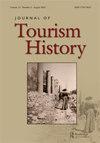Bona fide bites: the concentric authenticity of Boatwright’s Dining Hall
IF 0.9
Q4 HOSPITALITY, LEISURE, SPORT & TOURISM
引用次数: 0
Abstract
ABSTRACT At Walt Disney World’s Port Orleans Resort in Central Florida, the hotel’s restaurant, Boatwright’s Dining Hall, employs traditional southern and Louisiana cuisine to facilitate an immersive touristic experience inspired by the nineteenth-century US South. Opened in 1992, the restaurant and hotel present a romanticisation of the South embodied in foodways, architecture, and a fictional past that selectively sources the history of the region. Through the themed design principle of ‘concentricity’, the foodways of Boatwright’s Dining Hall operate in overlapping areas of cultural meaning to reciprocally authenticate the resort’s fabricated historical architecture and southern heritage in an idealised and immersive space known as a hyperreality. Named menu offerings at Boatwright’s Dining Hall connect the resort’s past and setting by memorialising the resort’s fictional founders and crafting associations with recreated southern spaces popularly connected to the region. As an authenticating experience, touristic consumption of food at Boatwright’s Dining Hall functions as a real and edible manifestation of a place-based commodified imagining of the nineteenth-century South, linking the dinner, restaurant, and hotel to a southern-inspired, fictional past and place, effectively displacing historic and present connections to the real US South.真正的咬:船赖特餐厅的同心真实性
在佛罗里达州中部的沃尔特迪斯尼世界奥尔良港度假村,酒店的餐厅Boatwright 's Dining Hall采用了传统的南部和路易斯安那州美食,为游客提供了沉浸式的旅游体验,灵感来自19世纪的美国南部。该餐厅和酒店于1992年开业,在食物方式、建筑和有选择地来源该地区历史的虚构过去中体现了南方的浪漫主义。通过“同心性”的主题设计原则,Boatwright餐厅的食物方式在文化意义的重叠区域中运作,在一个被称为超现实的理想化沉浸式空间中相互验证度假村的历史建筑和南方遗产。Boatwright餐厅的命名菜单通过纪念度假村的虚构创始人和与该地区普遍相连的南部空间的重建,连接了度假村的过去和环境。作为一种真实的体验,在Boatwright餐厅消费食物的旅游消费是19世纪南方基于地点的商品想象的真实和可食用的表现,将晚餐,餐厅和酒店与南方的灵感,虚构的过去和地方联系起来,有效地取代了历史和现在与真实的美国南方的联系。
本文章由计算机程序翻译,如有差异,请以英文原文为准。
求助全文
约1分钟内获得全文
求助全文
来源期刊

Journal of Tourism History
HOSPITALITY, LEISURE, SPORT & TOURISM-
CiteScore
0.60
自引率
0.00%
发文量
16
期刊介绍:
The Journal of Tourism History is the primary venue for peer-reviewed scholarship covering all aspects of the evolution of tourism from earliest times to the postwar world. Articles address all regions of the globe and often adopt interdisciplinary approaches for exploring the past. The Journal of Tourism History is particularly (though not exclusively) interested in promoting the study of areas and subjects underrepresented in current scholarship, work for example examining the history of tourism in Asia and Africa, as well as developments that took place before the nineteenth century. In addition to peer-reviewed articles, Journal of Tourism History also features short articles about particularly useful archival collections, book reviews, review essays, and round table discussions that explore developing areas of tourism scholarship. The Editorial Board hopes that these additions will prompt further exploration of issues such as the vectors along which tourism spread, the evolution of specific types of ‘niche’ tourism, and the intersections of tourism history with the environment, medicine, politics, and more.
 求助内容:
求助内容: 应助结果提醒方式:
应助结果提醒方式:


